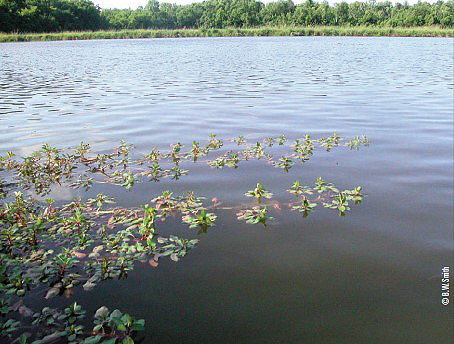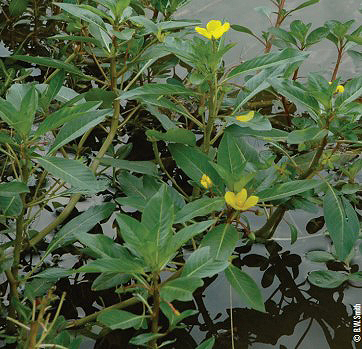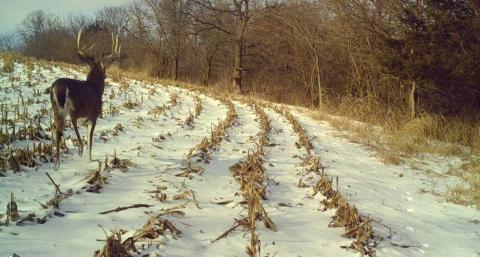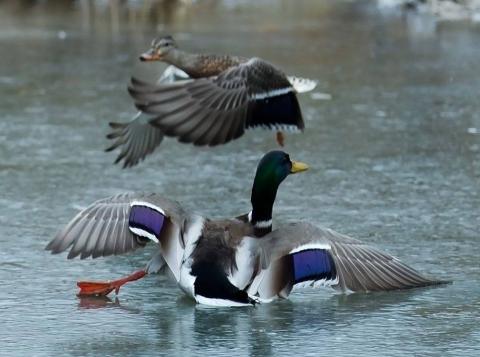Don C. Keller | Originally published in GameKeepers: Farming for Wildlife Magazine. To subscribe, click here.

the bank. This makes fishing difficult and provides habitat for
snakes.
I often compare managing a pond or lake to managing a garden. In early summer, one task all gardeners have to deal with is taking care of invasive grasses or weeds that seem to appear almost overnight.
In May or early June, I frequently get calls from pond owners about a plant that looks like it is forming mats along the shoreline and seems to be taking over. “My grass carp must be gone, because this stuff keeps spreading,” is a frequent comment.
What is Water Primrose?
Water primrose (Ludwigia sp) is a common aquatic marsh plant that is often found in swamps, ditch banks, ponds, lakes and shallow portions of reservoirs. There are over 30 species of primrose in the south, and some can be problematic and aggressive. One type, Uruguayan primrose, has thick red stems and forms large mats if left unchecked. It will grow horizontally over most soil or on the water surface. The leaves are somewhat spoon-shaped and are attached symmetrically around the horizontal stem. It may also have stems that are hairy and stand erect up to 30 inches tall. The erect stems will have elliptically shaped leaves with pointed tips. Primrose has a bright yellow flower with five petals.
Water primrose is found throughout the southern United States and it appears to be spreading into the eastern U.S. In areas where it is found, it aggressively invades marshes and shallow ponds. In many cases, it will quickly cover coves and marginal areas, and eliminate native emergent vegetation. It was thought that this type of primrose was brought to the states from South America, but it may actually be native to the coastal areas of South Carolina.

the floating purple stems of the plant. Before
developing the stems or "runners," Primrose may look
similar to alligator weed. However, the flowers of
alligator weed are white.
In most aquatic environments, the appearance of primrose is considered to be an undesirable occurrence. As previously mentioned, its aggressive nature allows it to out-compete native submersed and emergent vegetation that are beneficial to fish and wildlife. By dominating the plant life along the margins and in shallow coves, it eliminates plant diversity and reduces the wildlife value of a particular area. Water primrose appears to have very little food value for waterfowl, aquatic mammals, or other aquatic organisms. Also, floating mats created by water primrose can completely cover shallow embayments, and sometimes an entire pond. These mats accelerate sedimentation, thereby speeding up the death of a water body. These large mats also cause zones of extremely low oxygen during certain times of the year. Although there may be some protection for small fish from predation at the edge of a water primrose mat, the loss of spawning habitat, elimination of plant diversity and the low oxygen caused by the large colonies far outweighs any benefit of the cover it provides.
Controlling Water Primrose
How do we control primrose? Unfortunately, not with grass carp. Grass carp prefer to eat soft, succulent underwater or marginal vegetation. Primrose has a rather coarse, stiff stem which grass carp will not eat. However, there are several systemic aquatic herbicides that are approved by the EPA to be used in and around water. The least expensive is 2,4-D, which is sold as Weedar 64. The most commonly used systemic herbicide is one that contains glyphosate and is sold as Rodeo, Aquapro, Touchdown, Eager, or Aqua Net. These are effective and can be applied repeatedly to achieve plant reduction. Generally speaking, a two-percent solution of either one of these products, applied with a good wetting/sticking agent, will provide satisfactory control. You can improve control and effectiveness by adding one percent of 2,4-D to a two-percent solution of glyphosate plus a wetter/sticker agent. You may have to make more than one treatment to obtain the desired level of control. Since these products are systemic and the material must move in the plants to the root system, you should allow seven to 10 days to notice an effect on the plants. Remember also that once the plant is killed, it will take some time for it to biodegrade.
In summary, water primrose has few redeeming qualities and in almost every case it should be considered an undesirable addition to your pond or lake. Early detection and control of the small colonies can prevent many of the problems that occur as the primrose begins to form large, impenetrable mats. “Nip it in the bud” by spraying it early with the appropriate herbicide and you can save yourself considerable time and expense rather than trying to reduce the problem later on when it is in large mats.































